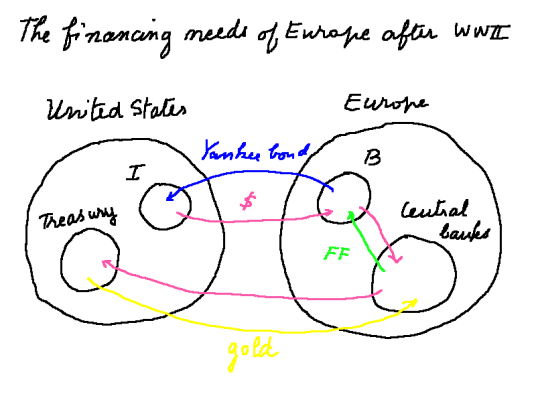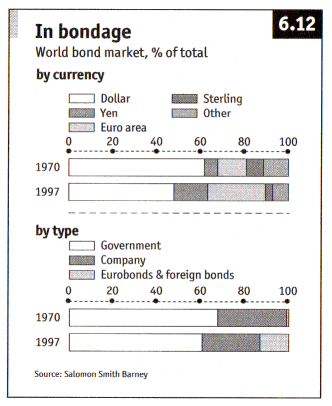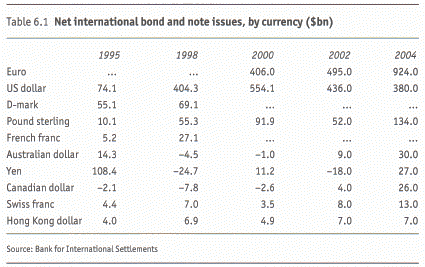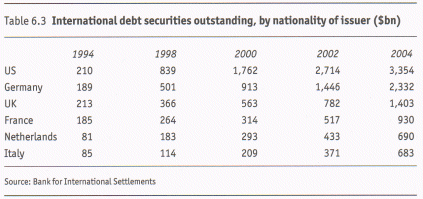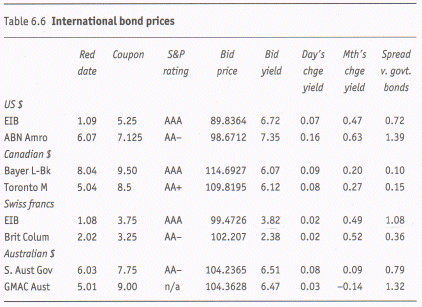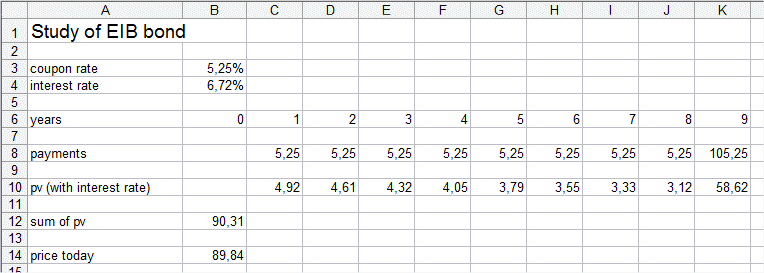Advanced financeLesson 6: International fixed-income markets
In this lesson (based in part on Levinson, chapter 6), we shall study various types of international financial instruments and also a first money which escapes the strict control of national financial systems.
Notice, the term "euro" in the last two products does not refer to Europe or its currency, but to the fact that the denomination is in another currency than that of the country where the instrument is located. Much will be explained on this, of course, because the notion of "location" of a financial instrument is not as obvious as that of my house for instance. In fact it refers to the authorities which have some regulatory powers on the instrument. Colourful names are given to foreign bonds: yankee bonds are dollar-denominated securities issued in the United States by non-US issuers; bulldog bonds are sterling pound-denominated bonds issued in Britain by non-English issuers; samourai bonds are yen-bonds placed by foreigners in the Japanese market. Kangaroo (or matilda) bonds are foreign bonds issued in Australia in australian dollars. Matadors used to be foreign bonds issued in pesetas in Spain, but since Spain is now in the euro zone, they no longer exist. Eurobonds also received picturesques names: sushi bonds are bonds issued in yens (usually by a Japanese issuer) outside Japan. Eurodollars, as we mentioned, are any dollar-denominated deposits outside the jurisdiction of the American monetary authorities. They bear interest, and are very much alike eurobonds. To fix ideas, here are the relative sizes of the various bond markets in 1970 and in 1997:
Source: "Economics, Making Sense of the Modern Economy", Edited by Simon Cox, The Economist Press, 2006, p158 By types: government bonds, followed by company bonds, still played the major roles in 1997. But the foreign and eurobonds began to be important. By currency: the dollar was still dominant in 1997, but the other currencies represented slightly more than half. In 2008 the trend was even more pronounced.
Foreign bonds Yankee bonds after WWII After WWII, European economies were in shambles. The countries needed to be reconstructed. The official name of the world bank, created at Bretton Woods, actually is the "International Bank for Reconstruction and Development". Bretton Woods also reorganised the monetary systems of European countries and linked them strongly to the dollar and ultimately to gold held by the United States. The European countries financial markets were also in shambles. They did not have the capacity to locally raise and lend the capital needed for reconstruction. One consequence was the Marshall plan, which is not the topic of this lesson. Another one was that European borrowers turned to the United States. They issued and sold bonds, denominated in dollars, to investors in the United States. These are called Yankee bonds.
Dantzig 1945 The European borrowers received therefore dollars. But the European economies were not completely "dollarized" though. So the borrowers converted their dollars into local currencies (French Francs, Deutsche Marks, Italian Liras, Sterling Pounds, etc.) at their central banks. And the central banks, in turn, sent the dollars back to the US in exchange for gold (see picture on top of page). This, in essence, means that Europe borrowed gold from the US in order to be able to finance its reconstruction. We have here a striking example of the fact that money is just signs: obviously gold, no more than French Franc bank notes, does physically contribute to the reconstruction. But Europe needed potent financial markets to support reconstruction. It could have issued a new currency. But the epoch was still profoundly influenced by the positive memory of the gold standard, and in fact Bretton Woods built a gold exchange standard. So Europe resorted to a strong currency pegged on gold, and actually changed it for gold. This gold in turn, owned by the European central banks, enabled them to feel comfortable issuing their local currencies to borrowers/issuers of Yankee bonds. In parallel, the dollar deposits in American banks plus short term US government notes held by foreigners went from $8 billion in 1950, to $20 billion in 1960. The United States seeing their gold reserves dwindle began to worry in the early 60's. In July 1963, Presidend J.F. Kennedy recommended that the US pass a law called Interest Equalization Tax, which would put a 15% tax on the interest revenues received by American investors on the Yankee bonds they had bought. The law was enacted in 1964. This and some other measures of the same nature did put an end to the haemorrhage of gold - at least the part due to Yankee bonds, because, later in the 60's, the Viet-nam war was another great cause of flight of gold (the US were pouring dollars into south Viet-nam, which in turn sent them to French banks, which exchanged them for gold...). This eventually lead, as we know, to the closure of the "gold window" in Washington, in August 1971, by President R. Nixon. The drying up of Yankee bonds had another unexpected consequence, as is often the case in finance and money, where, the reader will remember, most innovations are spontaneous: borrowers still needed capital to reconstruct Europe, and they still needed a strong currency (European currencies were subject to heavy inflation). So they began to issue bonds outside the United States, but still denominated in dollars. These are called Eurobonds. The first modern Eurobond is an issue of $15 million by the Italian freeway authority, Autostrade, in 1963. In 1964 the new issues already reached $1.2 billion.
Foreign bonds nowadays Due to the globalisation of the world economy, nowadays the line between foreign bonds and eurobonds is blurred. As of 2004, the amount of outstanding international debt securities was $14 000 billion, compared to $36 000 billion for outstanding domestic debt securities. The yearly growth of the former was about 20%, and that of the latter 8%. The net international bond and note issues are given below. We see that issues denominated in euros dominate:
Yet among the outstanding bonds, the dominant issuers are still American:
Some historical considerations Eurobonds, that is bonds issued in a country C, denominated in another currency than C's are not exactly a novelty of the 1960's. In the early XIXth century the Rothschilds were already issuing such bonds to finance their activities. For instance too, after the Franco-Prussian War, the Treaty of Frankfurt, stipulated that France had to pay a war indemnity of 5 billion francs in gold within five years, and Germany got back Alsace and a part of Lorraine. Then the Rothschilds organized the French issue of international bonds, denominated in various currencies, to raise the money to pay for this war indemnity (see Arnold Leese). France and Germany quarrel over who should "own" Alsace and Lorraine since Charlemagne's times. Between 1871 and 1918, die Universität Straßburg was a famous German university which formed or employed internationally known scholars. At the same time, in 1877, in France was published "Le Tour de France par deux enfants", a highly nationalistic book which was used in every French primary school until the 1950's. Before Westphalia treaty Alsace was German. As of 2008, it officially belongs to France, but if one visits this nice Rhine region, it feels distinctively German.
Generalities on international debt securities There are the three usual types of bonds: fixed-rate, floating-rate, and equity-linked (equivalent to convertibles). Most often an issuer B of an international bond will not refund it to the investor I in the same currency as the one in which the issue is denominated. The borrower B will, at the same time, enter into a swap contract with another market player J, to swap its payment obligations in the denominated currency for payments in another currency to J. And J will pay I in the initial currency. There are also swaps "fixed-for-floating". The biggest issue of a global bond, as of 2004, was France Telecom issue in March 2001 for a total value (in different currencies) of $16.4 billion. Below is a typical table of prices published in a financial newspaper:
For example, the first line presents data on a bond issued by the European Investment Bank some years ago and maturing in January 2009. Its coupon rate is 5.25%, which means that it pays yearly 5.25% of its face value. The going price at the time the table was published was 89.8364% of face value. Therefore its yield must be higher than 5.25%. Indeed the table gives 6.72%. (And we see that the bond is only 0.72% above government bonds of the same characteristics, so it is considered safe.) As an exercise on calculations about bonds, this figure of 6.72% enables us to calculate approximately when the table was published. Indeed we only have to check with how many years to go, a current price of 89.8364% (of face value) and coupons of 5.25% (of face value) represent an investment with IRR = 6.72%. Doing this with an Excel spreadsheet, we obtain 9 years. Therefore the table was published around January 2000.
Work in progress
Go to lesson 7 | |||||||||||||||||||||||
